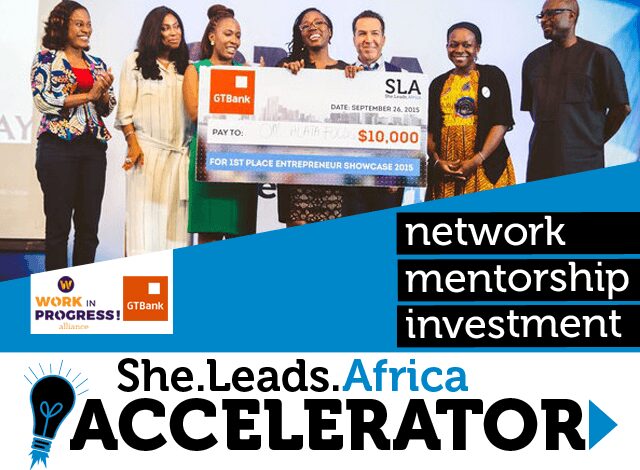Do male ideas rock and female ideas suck? 10 things women founders need to do to get funded!

[bctt tweet=”The statistics on Venture capital funding do not favour women founders” username=”SheLeadsAfrica”] You are a young woman, you are innovative, you have many ideas and you just launched a tech startup! Now, you need to get funded to take your startup where you want it to be. You have applied here and there and even made submissions and connections to venture capitalists but you are yet to make any headway and you know the survival of your startup depends on some fresh cash injection. It’s not getting any better because the statistics on Venture capital funding do not favour women founders. You see your business drifting into the number of un-funded women startups and you desperately need answers. Hi babe, are you there? If this is your experience as a female startup founder or entrepreneur, take a deep breath, you are so not alone. It’s no news that Venture Capital funding gender gap swings against women big time as male startup ideas get funded at a 16 to 1 ratio compared to those of women. According to Venture Capital database Pitchbook, Venture Capitalists invested $52.2 billion in male-run start-ups while female-run startups received only $1.46 billion in 2016. This figure paled in comparison to the other years in the last decade causing us to wonder if funding for women-run startups will ever get better. And why is this so? Do male ideas rock while female ideas suck? What do female founders need to do to get their start-ups funded in a male-dominated tech startup ecosystem which tilts towards men statups? Here are 10 things women founders can consider doing to get desperately needed cash to push their start-ups to the next level; 1. Learn as fast as male founders As a female founder, how fast do you learn? Are you comfortable with the things you know year in, year out or do you push your learning barriers to exhaustive levels? When it comes to male founders, we have seen them take drastic steps to get their startups going even if it takes pushing learning boundaries over and beyond their usual capacities. Then a Mckinsey management staffer, Eliam Medina undertook a one month crash course to learn how to code to get the first iteration for his free wills and legal service startup, Willing, up and running. And it is no surprise that more guys learn to code than girls. Data from Girls Who Code shows that computer science learning among women has reduced from 37% in 1984 to 18% presently. And when it comes to venture capital funding, one thing is clear, strong technical teams with a major bias for a technical founder is a good first step to knocking on VC doors for funding and getting their attention. Learning also traverses reading about other startup ideas like your life depends on it and using the successes and failures of other startup founders to your advantage. Who best is adopting this technique to create exciting startups than male startup founders, from 99designs to 99taxis, 99bitcoins, etc. Nikki Durkin, founder of defunct startup 99dresses has definitely seen men transform her failure into breathtaking successes which are also foundational to catching the eyes of investors. As female founders learning about one new idea a day can boost your strategy direction which gives investors the impetus to go with your call. 2. Have an idea arsenal and pick the best Consider why you started your startup in the first place. Was it out of your own need or a real need? While this may be tough to evaluate, candidly, it is best to have an idea arsenal. Your idea arsenal should be full of ideas which not only resonates with you but ones with real and researched needs with an addressable market size. Go beyond the scope of ideas for start-ups meeting only the needs of women. While this is not bad in itself, the venture world is run by men and they sometimes get lost when it comes to women specific ideas and don’t know why they should be investing. From this collection you have created, pick the best and launch it first. By the best, I mean the one with the most validation from prospects, possibly millions of people who will find this startup useful to them on probably a daily. This means that people can pay for what you have launched and the possibility of this is exciting to any venture capitalists. [bctt tweet=”The venture world is run by men & they sometimes get lost when it comes to women specific ideas” via=”no”] 3. Fail fast by launching other startup ideas Far from what most people who go into tech may think, creating a successful startup is not a Disney fantasy tale. The best startup founders did not necessarily hit it big on the first idea they launched. To put it in clearer terms, a lot of them ran with more than one idea. Stackoverflow founder, Joel Spolsky and his team had Trello and FogCreek up and running alongside. He opined that by chasing multiple ideas at once, anyone of them could succeed into the big leagues. Female startup founders need this perspective and be ready to fail fast like most of their male counterparts. This is because, no matter how lucrative an idea may seem, the time may not be right for its mainstream demand. This happened with all the devices created prior to Apple’s iPod and that should be the target of any female founder who wishes to be trolled with funding instead of actually chasing after it. 4. Spy for the extraordinary Venture funding, no matter how scarce they may be to female founders, can never shy away from the extraordinary startups run by women. Why is this? We have been ushered into a world of constructive and collaborative disruptions across industries all over the world, mostly spearheaded by technology. From Uber to Airbnb, Snapchat, Convene, and Spotify, we have seen tech ideas break the
10 Startups Selected For The Inaugural SLA Accelerator

Earlier this year we kicked off the first ever She Leads Africa Accelerator Program. In partnership with the Work in Progress! Alliance (VC4Africa and Oxfam) and Guaranty Trust Bank we set out to create a 3-month accelerator program designed to identify, support and fund the next generation of Nigeria’s brightest female entrepreneurs. The SLA Accelerator received applications from over 120 startups from across Nigeria. The selected entrepreneurs were evaluated based on their traction and progress in the market, management team and vision to grow and scale across Africa. The selected businesses are: Fresh Direct Produce and Agro-Allied Services – An eco-friendly social enterprise that produces premium organic produce through hydroponics and community action. DeliveryBros – Helps you save time and stress through pickup and drops from the market to your house or office. Medsaf.co – Solves the medical industry’s procurement problem, by providing a technology enabled distribution solution resulting in transparency and simplicity. Koko’s Kitchen – An indigenous brand of confectionary dry mixes specially tailored to suit the taste buds and pocketbook of the quintessential person on the go. Bubble Tii – Bringing the Bubble Tea phenomena to Africa. Shuttlers – Enables professionals to access comfortable and efficient transportation to and from work using seat matching technology. Keek’s – Designs tailored weight loss packages for busy women who want a plan that is both effective and simple to implement. Art Splash Studio is a virtual art studio offering a social art experience through our Paint Nite painting classes hosted at different venues in Abuja. Paint, eat, and sip on cocktails while you create. Our instructors will guide you. So bring your friends and let’s have an art party! BathKandy Co. – Creates sumptuous dessert-inspired beauty treats for women who crave the finer things. Independent Personal Assistant (iPA) – Provides strategic virtual assistance to high-level executives across Africa. We take care of the mundane while you focus on what matters. SLA Accelerator participants will spend the next three months working on their business strategy and growth, while networking with investors and potential partners. Experts and program mentors include Chudi Amu, Vice President of Investment at Verod Capital; Shirley Somuah, Investor at Cardinal Stone Partners; Seun Abolaji, Creative Director at Wilson’s Juice Company; and Tunde Kehinde and Ercin Eskin, Cofounders of ACE. The entrepreneurs will have the opportunity to pitch their businesses at an investor Demo Day in October and compete for N2 million investment from She Leads Africa along with other business support services. Congratulations to all of the selected entrepreneurs!
10 things I learned about pitching to an investor

She Leads Africa recently had a free webinar session with Andrea Barrica on the fundamentals of pitching your business – The Do’s and Oh No She Didn’t of Investor Pitching. Andrea Barrica is a Venture Partner at 500 Startups, a global seed fund and accelerator for early stage startups based in Silicon Valley. She was previously co-founder at inDinero, an accounting and taxes software solution where she led the team to the first $1M in sales in 10 months. Here are ten things we learned from her. 1. Don’t try to pitch to all investors Most of the interactions that you have with investors are not investor pitches. Most of the interactions that you have with investors are about how you can get the right type of investor who wants to hear about your company and is willing to hear about your pitch. When you have an investor who is interested, it is then time to have the investor pitch. 2. Differentiate yourself, be clear, and don’t overly pitch Create a level of personal connection. People invest in people they like. Make it a conversation (never corner someone in a party). Keep it brief, and tell your story in 60 seconds or less. Understanding the market and asking questions and advice versus pitching the business is a great way to get investors interested. Be natural, authentic, and humble. 3. If you do not have an idea, investors will not be willing to invest Support your idea, prove it out Wait until you have traction and a great team Wait until you really need the money. However, when you really need the money the most, the investor has all of the leverage versus having a great team and traction without the desperation. 4. Use your resources, networks, and community to find investors Meet people — It’s better to meet investors when you’re not fundraising Standard networking — get introductions from other investors Go where investors hang out and then find the ones that you respect Write — start writing your own blog and content The key is running your business—it is important to build, go out there and get some traction. The first investors will be family and those you are close to. 5. When meeting investors, know who is going to be there, and how many people—know your audience! The important thing to know about a meeting is that, no one is as interested in you as you think they are. You must be brief. Think about how to you make your presentation interesting. How will you make it unique? 6. If you want to stand out, work the room, run the meeting, tell a story Make a personal connection, research the people in your room. Don’t make it to feel robotic; not too many slides. If people ask questions at the end and if what you presented was clear, that means that they are interested. Don’t leave asking: are you interested? Rather leave with: will you be willing in investing; how much will you be willing to invest? 7. The don’ts Pitching is a conflict between what we say, what we mean to say, and what the person actually hears. What we say and what we mean to say is not what the investors hear. Don’t: Create slides first This is a bad way to start a presentation. So don’t rely too much on your decks and your slides. Don’t: Be A 1 pitch pony. Don’t only have one pitch prepared Have more than one prepared. Prepare for the different types of investors and what they may care about most. Don’t: Forget the 20:1 rule For every one minute of a presentation, practice out loud. Make sure the delivery and confidence is there. 8. The do’s Do: Tell a strategic story Tell a story that will help the listener understand something about your story that they didn’t before. How does my story help me to achieve my goal? It is important to ground out the things that you want people to know about you in short stories. Do: Know your secret sauce How will you win when everyone else fails? It is your differentiation. Do: Know what is the most compelling thing about your business Use this cheat sheet: Traction Team- past experience and your background Product Vision Do: Pass the 60 seconds test You need to get someone interested about your company in 60 seconds, no matter what industry you are in. 9. If you want to get in touch with foreign investors, build a great business They will reach out to you. Make sure people know you. How so? Support local organizations. What are you doing? What problem are you solving? How do you understand the market? 10. You close deals A great pitch deck and a horrible pitch won’t do anything for you. So how can you improve? Get together a small group of other young entrepreneurs and force yourself to practice consistently. Go out to new events and networking opportunities and keep pitching. You won’t get good unless you do it. Take improv classes or acting classes. Have a few friends video tape you pitching and talk about ways to improve with your friends. The only way that you will improve is by giving and getting brutal advice—patting each other on the back, will not help. Want to watch the full webinar? Check out the video below:
Webinar with Andrea Barrica: The Do’s & Don’ts of Investor Pitching (Feb 2)

Don’t miss another event! Join our community and always stay informed. [vc_row][vc_column][vc_custom_heading text=”RSVP for the webinar” font_container=”tag:h2|text_align:center|color:%23ffffff” use_theme_fonts=”yes” link=”url:https%3A%2F%2Fplus.google.com%2Fu%2F0%2Fevents%2Fcdig7e0ir5ci7h33r7napcvkts8||target:%20_blank” css=”.vc_custom_1454250856561{border-top-width: 2px !important;border-right-width: 2px !important;border-bottom-width: 2px !important;border-left-width: 2px !important;background-color: #d1d1d1 !important;border-left-color: #d1d1d1 !important;border-left-style: solid !important;border-right-color: #d1d1d1 !important;border-right-style: solid !important;border-top-color: #d1d1d1 !important;border-top-style: solid !important;border-bottom-color: #d1d1d1 !important;border-bottom-style: solid !important;border-radius: 4px !important;}”][vc_column_text]If raising capital from an investor is one of your top business goals for 2016, then you need to join us on February 2 for a special webinar with an experienced entrepreneur and venture partner from Silicon Valley. Some of the questions we’ll cover: At what stage in your business should you be looking to speak with investors? How long should your business pitch be? How can you find investors interested in your business? Do you need a professionally designed pitch deck? About Andrea Barrica: Andrea Barrica is a Venture Partner at 500 Startups, a global seed fund and accelerator for early stage startups based in Silicon Valley. She was previously co-founder at inDinero, an accounting and taxes software solution where she led the team to the first $1M in sales in 10 months. Andrea was a guest trainer at She Hive Lagos and coached our bootcamp participants on effective pitching and is excited to work with the SLA community again. RSVP for the webinar here. Make sure you’re part of our community to get access to more upcoming events and programs. Want to learn more about preparing for pitch events and competitions? Read our article on 4 things you must have to be pitch perfect.[/vc_column_text][vc_custom_heading text=”RSVP for the webinar” font_container=”tag:h2|text_align:center|color:%23ffffff” use_theme_fonts=”yes” link=”url:https%3A%2F%2Fplus.google.com%2Fu%2F0%2Fevents%2Fcdig7e0ir5ci7h33r7napcvkts8||target:%20_blank” css=”.vc_custom_1454250918263{border-top-width: 2px !important;border-right-width: 2px !important;border-bottom-width: 2px !important;border-left-width: 2px !important;background-color: #d1d1d1 !important;border-left-color: #d1d1d1 !important;border-left-style: solid !important;border-right-color: #d1d1d1 !important;border-right-style: solid !important;border-top-color: #d1d1d1 !important;border-top-style: solid !important;border-bottom-color: #d1d1d1 !important;border-bottom-style: solid !important;border-radius: 4px !important;}”][/vc_column][/vc_row][vc_row][vc_column][vc_video link=”http://www.youtube.com/watch?v=WGA7ZMH0vBk”][/vc_column][/vc_row]
Quick Read: Your 1 minute guide to startup financing
You already know that it takes more than a stellar business plan and an ace team for your startup to thrive. You also need financing to get your ideas off the ground. COLD. HARD. CASH. But what type of financing is available for me, you ask? Well, you have 3 options: 1. DEBT FINANCING Your company receives a loan and gives its promise to repay the loan. It includes both secured and unsecured loans, and can be long-term or short-term. Pros: You aren’t giving away any part of your business. Cons: Defaulting on the loan = signing your life away. 2. EQUITY FINANCING Your company obtains finances from potential investors, family and friends, business angels or by issuing an Initial Public Offer (IPO). Pros: You are not obligated to pay a dividend Cons: Equity finance generates capital from external investors in return for a share of the business. 3. MEZZANINE FINANCING This is a combination of both debt and equity financing. It begins as debt capital that gives the lender the rights to convert to an ownership or equity interest in the company if the loan is not paid back in time and in full. This type of financing allows the owner both debt and equity options. Pros: Allows you to get the money you need without giving up a huge chunk of your company’s ownerships…as long as you pay your debt on time. Cons: Interest rates are much higher than traditional debt financing. Want to learn more about financing and savings options for your business? Visit PAL Pensions to learn more about their unique products for young entrepreneurs.
